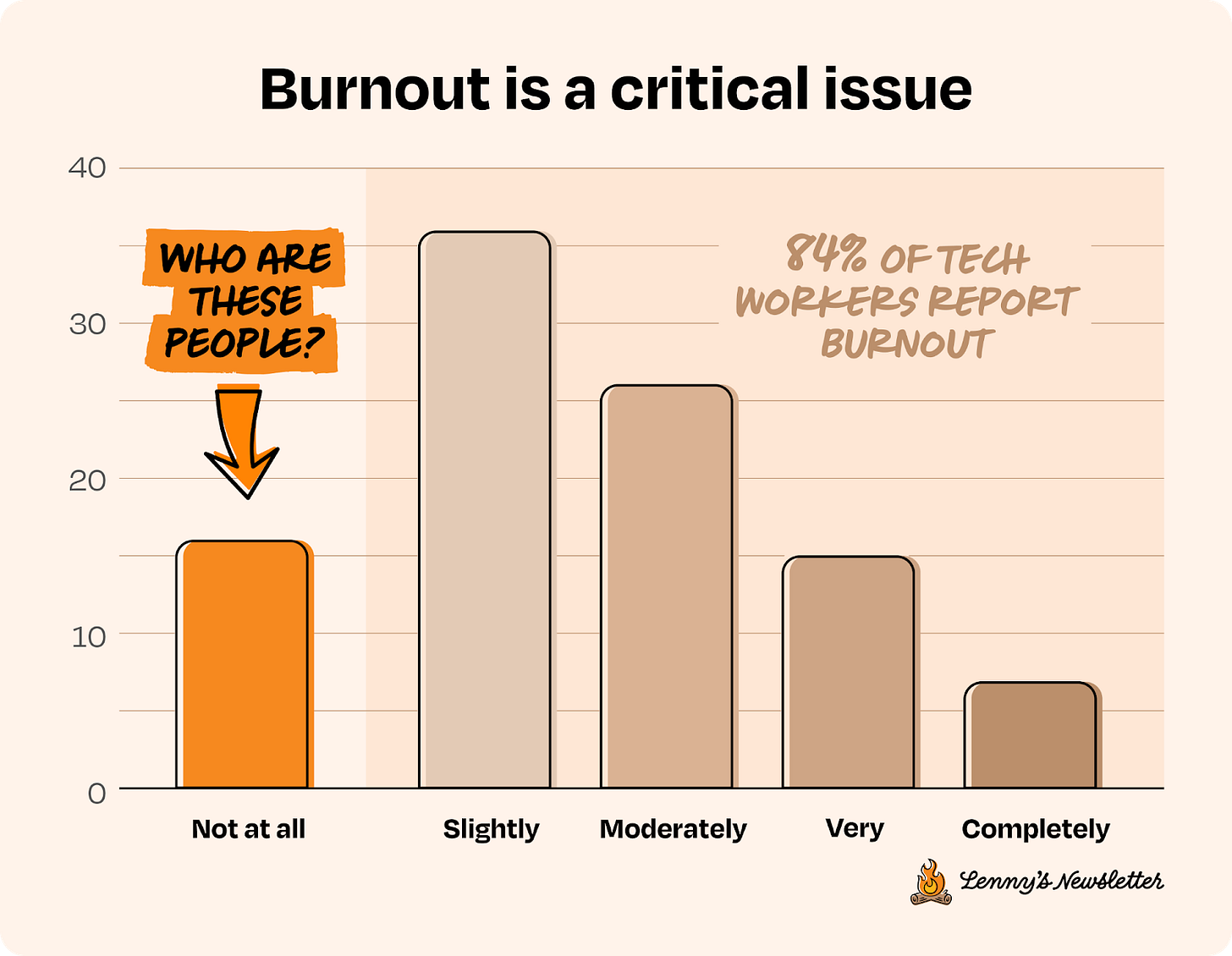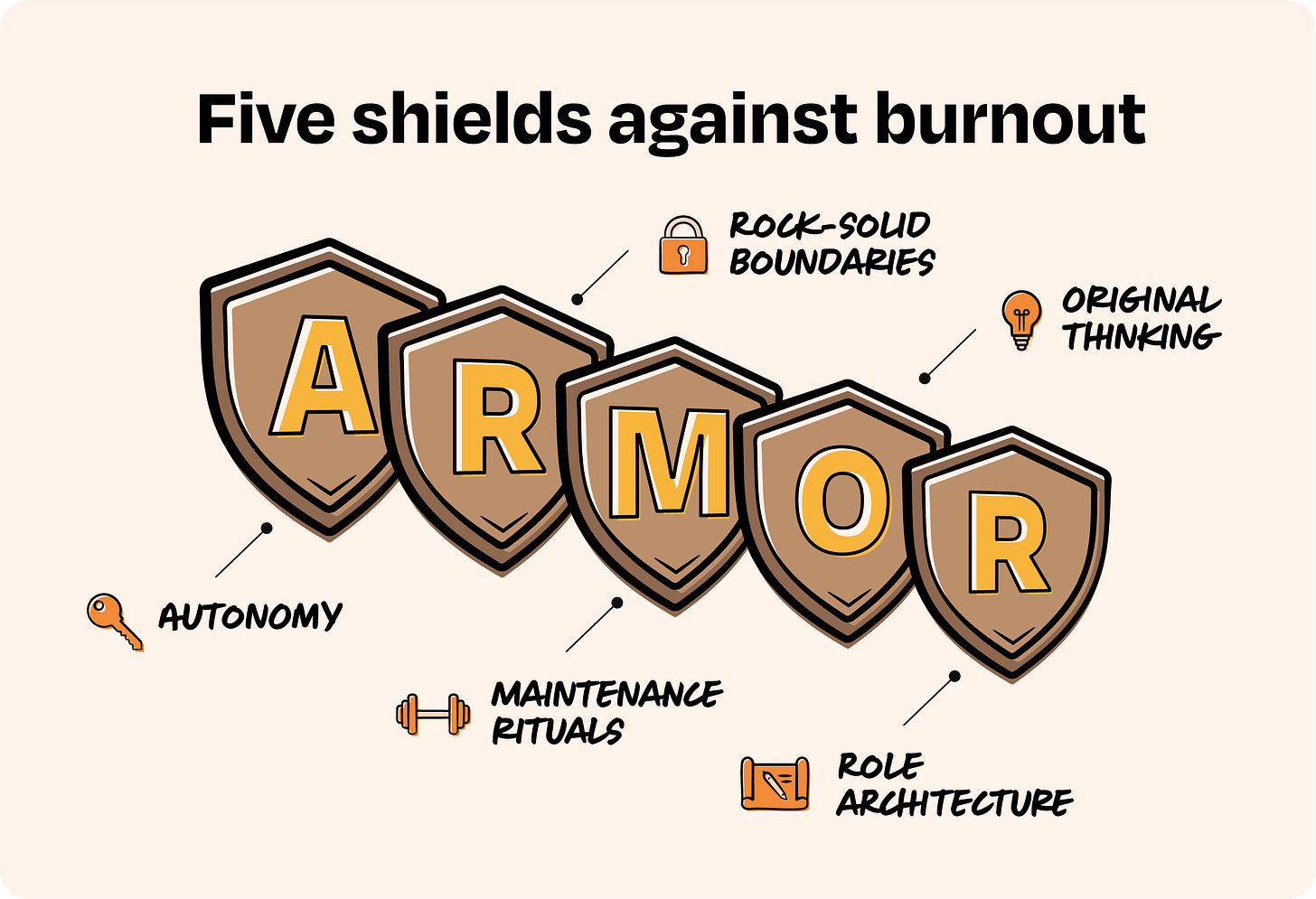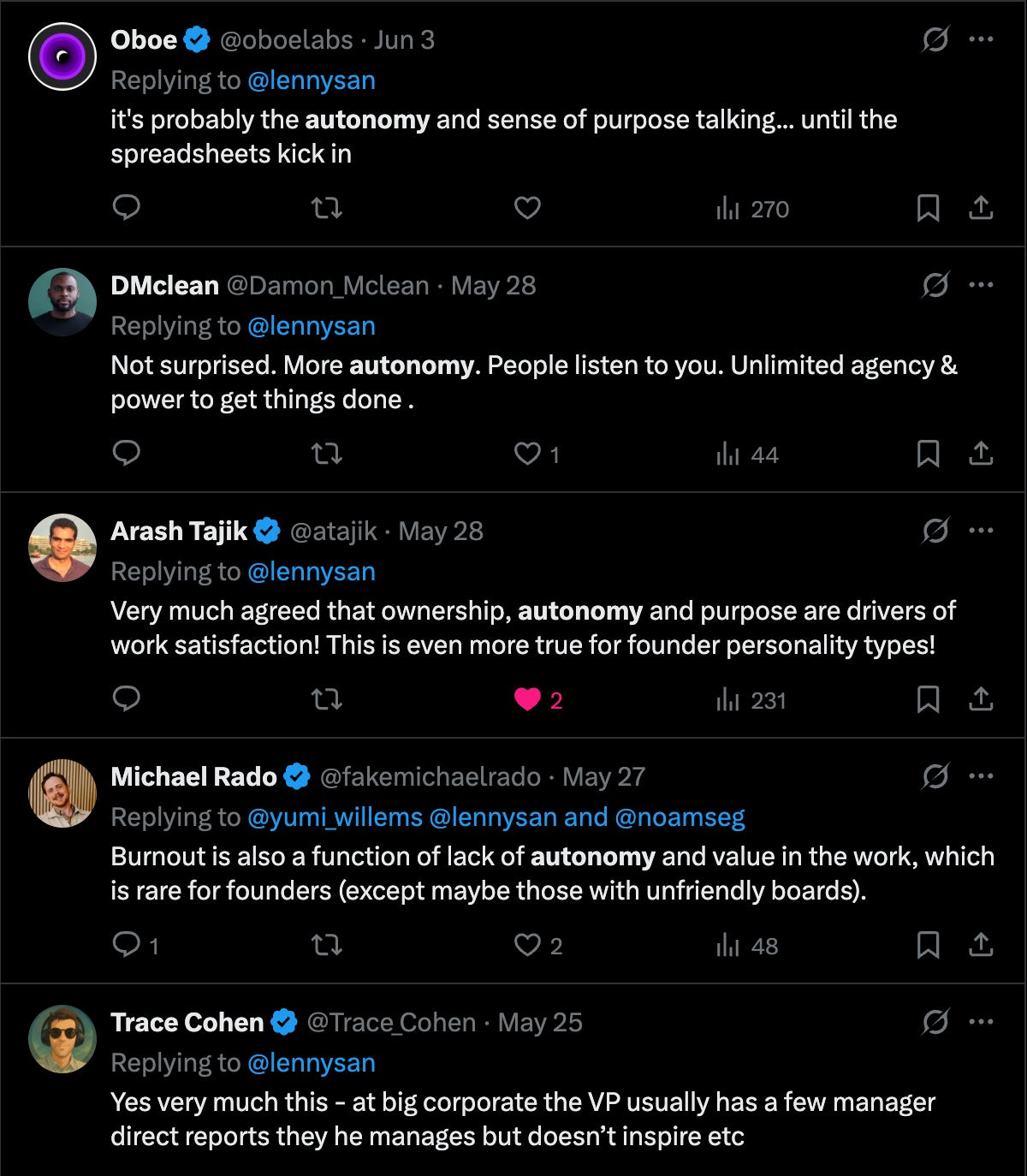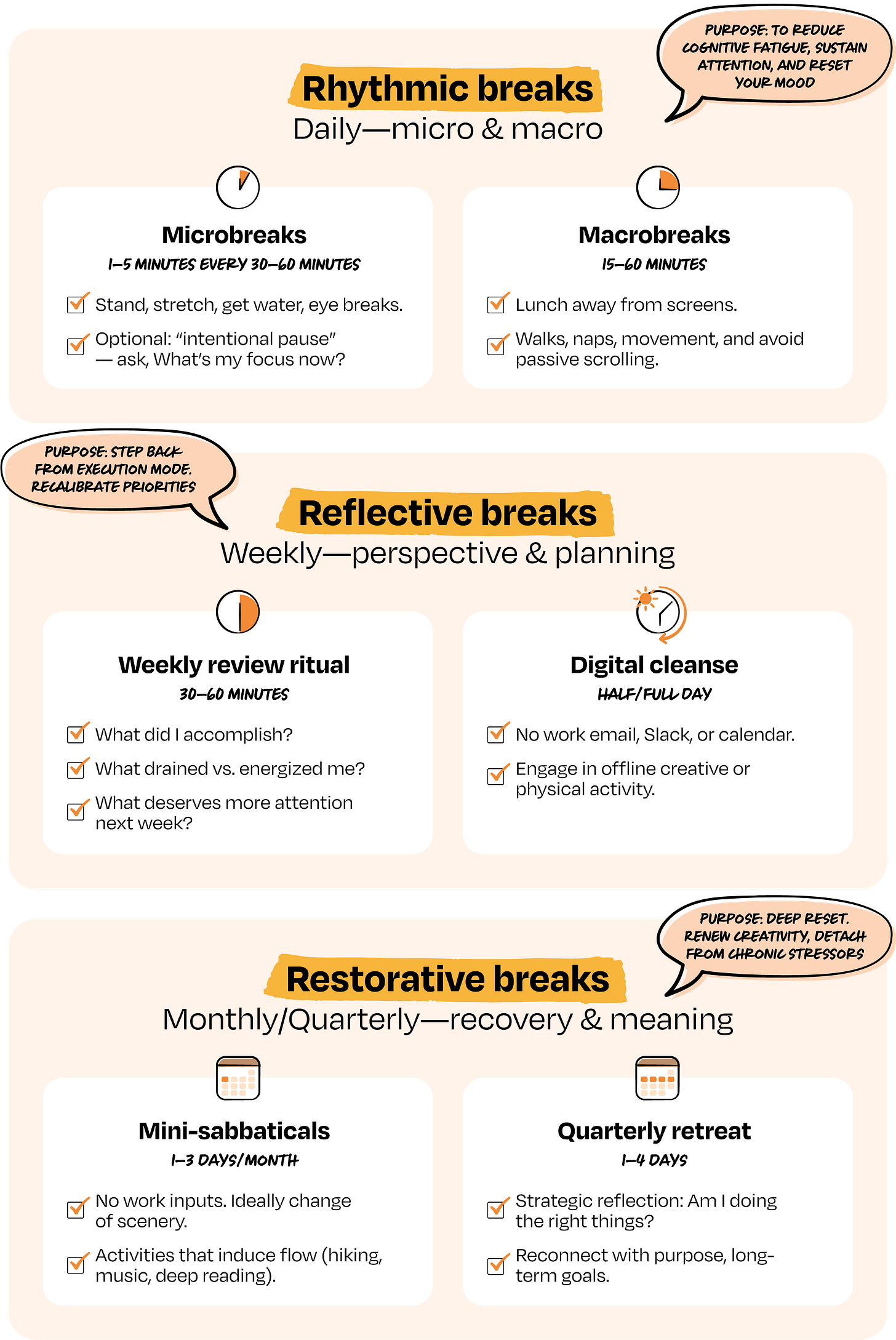How tech’s most resilient workers handle burnout
Introducing ARMOR: a new framework building on our tech worker sentiment survey insights
👋 Welcome to a 🔒 subscriber-only edition 🔒 of my weekly newsletter. Each week I tackle reader questions about building product, driving growth, and accelerating your career. For more: Lenny’s Podcast | How I AI | Lennybot | Lenny’s Reads | Courses | Swag
Annual subscribers now get a free year of Bolt, Perplexity Pro, Notion, Superhuman, Linear, Granola, and more. Subscribe now.
Three weeks ago, we shared the results of our first-ever large-scale tech worker sentiment survey. The post generated tons of conversations, in particular about burnout. Readers asked, “Who are these people who aren’t burned-out?”
So we decided to do a timely follow-up investigation to find out the common threads among respondents who:
Haven’t felt much (or any) burnout in recent months/years
Have felt burned-out but were able to deal with it extremely effectively
Feel like they’ve cracked the “secret code” for dealing with burnout
We ran open-ended, video-based surveys with about 175 respondents and interviewed about 15 people who reported low to no burnout in the original survey.
Our respondents revealed that dealing with burnout isn’t simply about resilience or stress management. The key is to systematically design a career and lifestyle that make burnout structurally unlikely.
We call tech workers who manage to do this “burnout conquerors.”
P.S. If you prefer, you can listen to this post in convenient podcast form: Spotify / Apple / YouTube.
Introducing ARMOR: five shields against burnout
My investigation revealed five core strategies for dealing with burnout. These strategies are the armor that tech workers are donning to protect themselves from burnout.
A: Autonomy
Many people we heard from immediately identified that autonomy is a critical ingredient to being happy at work.
We also saw this again and again in our research.
“I’ve had strong leaders who believed in my development and let me run with high autonomy to solve challenging problems. I’m happy more than 95% of the time.”
“I intentionally seek out environments where I have autonomy and variety in my day-to-day work, which keeps things fresh and prevents stagnation. Ultimately, choosing a path that matches my strengths and curiosity has made all the difference in sustaining my motivation and well-being.”
Burnout conquerors continuously strive to create as much autonomy over their work lives as possible. Here’s how:
1. Proactively take control of your time and efforts
Burnout conquerors keep a keen eye on how they spend their time and energy at work to make sure they’re working smarter, not harder. An open block in their calendar to do deep work isn’t just going to drop in from the sky. Their most productive hours aren’t going to magically become available for priority work. Burnout conquerors make their days their own.
“For me, burnout happens when I become ineffective at my job, no matter how many hours I put in. When I start to feel like I’m not making progress, I immediately start examining why. A perfect example is right now—I’ve not moved the needle with my priorities in weeks. There’s been a lot of firefighting, but nothing proactive. I started to examine what I’m spending time on and how I can pivot to spending time on what I should be doing. Calendar audit was step #1, declined meetings I really didn’t need to be in, blocked off heads-down time, and, in a matter of days, I’m back on track.”
2. Hit your goals to build trust
Rather than expecting trust in the workplace, burnout conquerors earn it by consistently delivering regardless of the external circumstances. The more you deliver on what you promised, the more everyone will trust you and leave you alone to do what you need to do. But that trust is not granted; it’s earned through behavior and successes (which is accomplished by taking control of time!).
“I control what I do; I control my success. I’m responsible for my failures. Some days are hard, and some people are difficult, but I choose how to respond and handle the situation to deliver on my goals.”
To get this done, burnout conquerors focus on small sets of quality outcomes driven by highly targeted goals, which they communicate up, down, and all around.
3. Overcommunicate your needs to others—and yourselves
Burnout conquerors understand their own needs and communicate them clearly and appropriately to the people around them. They know that when people know what to expect of you, they are rarely caught off-guard and feel more comfortable letting you take the wheel. A common tactic for burnout avoidance we heard is to “overcommunicate” about everything.
That includes far more than just what you’re working on and what resources you need to get it done.
“Most of my peers focus on communicating what they’re working on. They forget about [communicating] the ‘hows’: their boundaries, their constraints, and their strengths.”
Burnout conquerors overcommunicate how to best work with them and how they like to communicate, receive feedback, and make decisions. Set the foundations of those conversations with a “How I Work” document. Find a template here. (Also, learn to manage up generally.)
R: Rock-solid boundaries
Burnout conquerors know that to ruthlessly protect their time and energy, they need to erect boundaries that can withstand the pressure of a fast-paced and results-driven workplace. Here’s how:
1. Set, automate, and, yes, overcommunicate clear work-life boundaries
Burnout conquerors create consistent time-based (e.g. “I’m ending the day at 6 p.m. to be with my kids”) or task-based (e.g. “I’ll focus on 3 to 5 essential and urgent tasks each day”) hard stops. Anything beyond that time or list gets pushed to another time (or delegated to AI agents).
“I try to be strict about when I’m not going to do work. More than generic advice about ‘disconnecting,’ setting really clear micro-rules for myself has helped me prevent work stress seeping into the rest of my life. I know it might sound sad to even need these micro-boundaries, but it was necessary, and it’s been incredibly helpful.”
To ensure that those boundaries hold, the people we heard from automate their after-hours responses and set clear calendar blocks, so people get notified when they’re unavailable. They also share their working schedule with their colleagues up front, including daily constraints and personal needs, and then as needed when those boundaries get tested (which they always do).
2. Get comfortable saying no
Boundaries will always get tested by new requests or projects—some of which are exciting and seriously appealing! But there’s always an opportunity cost. Burnout conquerors understand that saying yes to something means saying no to something else.
They reframe no’s as tradeoffs—to themselves and others.
“I don’t frame responses to colleagues with open-ended questions that block my ability to define a ‘ready’ state. To overly simplify, I don’t say, ‘I have options A or B. Which do you want?’ I say, ‘I have option A and B. Here’s how we got to these options. Here are the tradeoffs. Please let me know your thoughts. I’ll move forward with A if I don’t hear any new feedback.’”
“I read this book called You Have a Choice by Eric Nehrlich. One of the big unlocks for me was ‘You don’t have to do anything you don’t want to . . . as long as you’re okay with the consequences.’”
3. Take real breaks: rhythmic, reflective, restorative
Breaks are necessary and reasonable for the roles and responsibilities we all have in this industry. Performing at a high level is essential at work, but turning off is too.
“Someone once told me, ‘We’re not performing brain surgery,’ and it was such a good reality check. Unless you’re a literal brain surgeon, it’s OK to not be perfect and available all the time. When I’m on, I’m on 100%. And when I’m off, I’m off 100%.”
We heard a lot about the types of breaks that are successful in helping people prevent burnout. We categorized them into three types.







